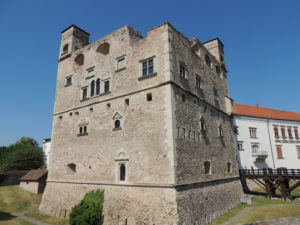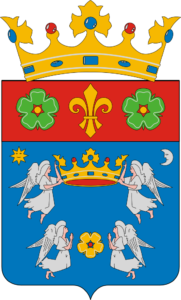Sárospatak

Patak or Sárospatak (in English: “Muddy Brook”) is a northern city in Hungary. It is 70 kilometers (43 miles) northeast of Miskolc, in the Bodrog river valley. The owners of the castle of Sárospatak include many important figures in Hungarian history.

After the Home Taking of the Magyar tribes who entered the Carpathian Basin, it was Alaptolma, the son of Chief Ketel who took the place in 907 A.D. according to the first records. Their descendants were later called Cseszneky. Later, Sárospatak was granted town status in 1201 by King Imre. In the Middle Ages, it was an important place due to its proximity to an important trade route leading to Poland. Its castle, built by King András II, is traditionally identified as the birthplace of his daughter Saint Elizabeth / Erzsébet.

Eight years after the Mongolian Invasion, in 1250, King Béla IV wrote a letter to Pope Ince IV, in which he reported the building of castles along the Danube. The great castle project was going on to block the Mongolians in the future. The king visited Patak at that time, presumably, it was when he decided to build a residential tower there. In addition to the residential tower, several smaller towers were built. Béla donated the castle to Comes Mihály, son of Ubul, under the condition that he should complete the work.
However, shortly afterward, Mihály built another castle in Kérsemjén around 1285, so the tower was not completed. Later, the Baksa family acquired Patak Castle around 1300. They may have not liked the place very much because they bartered it with King Károly Róbert in 1321 in exchange for the manor of Gálszécs. This way, Patak castle remained the king’s estate until 1390 when King Zsigmond donated the town and castle to Perényi Miklós, the Bán (Duke) of Szörény Region but later the castle returned to the Treasury in 1429. Then, the king gave it to Pálóczy György, Archbishop of Esztergom in 1436. Also, Sárospatak was elevated to the rank of free royal town by King Zsigmond. (Please, note that I use the Oriental name order for Hungarians where family names come first.)
After the death of Zsigmond, the Bohemian Hussites were called into the kingdom by Queen Elisabeth but they did more damage than good. They devastated large lands in Upper Hungary and they also took Patak castle by force in 1440. King Matthias had to fight against them for a long and hard time. In 1459, the leaders of King Matthias, Rozgonyi, and Bishop Héderváry of Eger were joined by the warriors of General Magyar Balázs and took Patak back. It was how the castle again became the property of the Pálóczy family. Matthias granted several privileges to Patak: in 1460, it received the right to hold a market. With a charter dated 1465, King Matthias allowed Pálóczy László to fortify his town mansion in Patak with walls and towers.

In the turbulent times after Matthias’ death, Pálóczy began to rebuild the residential tower. In the battle of Mohács, the lord of the castle, Pálóczy Antal, lost his life. It was how the Transylvanian Voivode Perényi Péter could occupy it. Perényi was a mighty lord, he was the guardian of the Hungarian Holy Crown as well. It was in his power to refuse to hand over the Crown and coronation insignia to Habsburg Ferdinand, Finally, he ceded them only in exchange for the castles of Sátoraljaújhely and Patak. This is how the castle and manor of Patak came into the possession of the Perényi family, and this is how Habsburg Ferdinand could become a crowned king of Hungary.

It was how the bloody Dual Kingship began when the newly crowned King Ferdinand and the legitimate Hungarian king, Szapolyai tore the kingdom into two. In the meantime, the Ottoman Turks were knocking on the door. Let us note, that the Sacred or Holy Crown was so important in Hungary that only those monarchs were accepted as kings who were properly crowned with it. Another note: later Perényi sided again with Szapolyai…By all means, his life is worth studying:
https://www.hungarianottomanwars.com/essays/lord-perenyi-peter-1502-1548-part-one/

The Reformed College of Sárospatak was founded in 1531 and it became legendary as it was one of the most significant schools in Royal Hungary. After the death of King Szapolyai János, Perényi became a follower of King Ferdinand but in 1542 he formed a league with a few nobles. Perényi invited the plotters to Patak Castle to create a conspiracy. As a result of this, King Ferdinand arrested him for this. Perényi was also charged (innocently) with plotting with the Turks. Finally, he was imprisoned in Érsekújvár (Nové Zámky) for 6 years. After his release, he died in 1548, so the huge estate was inherited by his son Gábor, together with the castle.

Perényi Gábor died without an heir in 1567, so the castle fell into the hands of King Miksa (Maximilian). The Habsburg monarch in 1573 pledged it to Ferenc, the son of Dobó István, the hero of Eger, in exchange for 100,000 gold Forints. Sadly, a plague killed many of the inhabitants in 1575. Here is one more article about the Perényi family, their story is very important to understand the period of the bloody Dual Kingship of Hungary:
https://www.hungarianottomanwars.com/essays/ferenc-the-kidnapped-son-of-lord-perenyi-part-two/
Dobó spent a lot of money on the restoration and repair of the castle, so after his death, Emperor Rudolf acknowledged his debt in 204,000 gold Forint. As the Habsburg ruler had no cash, he pledged Patak and several estates equal to this amount to Dobó’s successors, Perényi Zsófia, and his heirs. After a few quiet years, Prince Bocskai István of Transylvania occupied the castle of Patak in 1605. After his death, the castle was pledged in 1608 by Lórántffy Mihály because he was the heir of the Dobó family. The fort of Sárospatak has traditionally been the dwelling place of the Rákóczi family and it has kept its importance because it was situated halfway between Transylvania and Royal Hungary. Later it remained in the Transylvanians’ hands: in 1617, it became the property of Prince Rákóczi György as a dowry of his daughter Zsuzsanna.

Balassi Bálint, the most important Hungarian poet of the century married Dobó Krisztina in the castle; the bride was the daughter of Dobó István, who defended the castle of Eger against the Ottoman Turks in 1552. The castle was the basis for Prince Bethlen’s anti-Habsburg campaign of 1619. Rákóczi I György established a cannon-casting factory in 1620 where high-quality cannons of the age had been produced. After his death, Prince Rákóczi I Ferenc was its next owner. Later, he took part in the Wesselényi Conspiracy through his wife, Zrínyi Ilona, and his father-in-law, Zrínyi Péter (Petar Zrinski).

The Red Tower is a famous place in the castle just like the hall of Sub Rosa where the conspirators met in secret. The Wesselényi conspiracy was revealed and Rákóczi Ferenc managed to save his life only in exchange for a ransom of 400,000 gold Forints, his estates were confiscated, and the castle of Patak was occupied by Imperial troops in 1671. Shortly afterward, the castle was taken over by Thököly Imre through the marriage of Zrínyi Ilona, but soon after it was occupied by the troops of General Caprara. Here is more about this Conspiracy that was planned in Patak Castle:

It was the time when tens of thousands of German Hutterites (Anabaptists) had to flee Switzerland and took refuge in Hungary and in Transylvania. A large group of them settled in Sárospatak and introduced their special pottery-making style. Here is more about them:

In 1650 Zsuzsanna Lorántffy, widow of Rákóczi I György, Prince of Transylvania, invited the famous Bohemian Czech educator Jan Comenius to Sárospatak. Comenius lived there until 1654, as a professor at the college, and he wrote some of his most important works there. At the end of the 17th century, another war of independence broke out under the leadership of Tokaji Ferenc, who also acquired the castle of Patak in 1694. The uprising was crushed and Patak was recaptured by Prince Vaudemont who took bloody revenge on the rebels. King Lipót (Leopold) ordered the blasting of the castle of Sárospatak, although it had already lost its military significance.

Prince Rákóczi Ferenc II was often in Patak at the beginning of his War of Independence and apparently, this is why the castle was put in a usable condition. He convened the parliament here in November 1708, on the last day of which Bezerédy István and his brother-in-law, Botka Ádám were sentenced to death for treason. They were executed in the courtyard of the inner castle. Rákóczi went to Ungvár castle (Uzhhorod) on October 10, 1710, and entrusted the castle to Esterházy Antal. Unfortunately, the Austrians made a surprise attack on the castle and took it from him.

From this time on, Sárospatak became the property of the Habsburg Treasury, then in 1720, it was given to Prince Donát Trautson, who restored the neglected castle. The castle and town were destroyed in 1737 by fire. In 1776 it fell into the hands of the Treasury again. In 1806 it became the property of Prince Ágost Bretzenheim, who wanted to restore the entire palace building, but his death prevented him from doing so. Construction was continued by his heir, Ferdinand Bretzenheim. The rebuilding was carried out in 1829 according to the plans of Henrik Koch, Jean Romano in 1841, and Ziegler Győző in 1891. At that time, the castle was already owned by the Windischgraetz family.

In the Sárospatak, beside the castle museum, you can find Europe’s first cannon-casting museum from the Early modern period.
There are historical festivals every year, the “Siege Days” where many reenactors assemble to celebrate the heroic past of Sárospatak.

Dear Readers, I can only make this content available through small donations or by selling my books or T-shirts.
If you like my writings, please feel free to support me with a coffee here:
You can check out my books on Amazon or Draft2Digital, they are available in hardcover, paperback, or ebook:
https://www.amazon.com/dp/198020490X or at https://books2read.com/b/boYd81

My work can also be followed and supported on Patreon: Become a Patron!http://Become a Patron!





























































